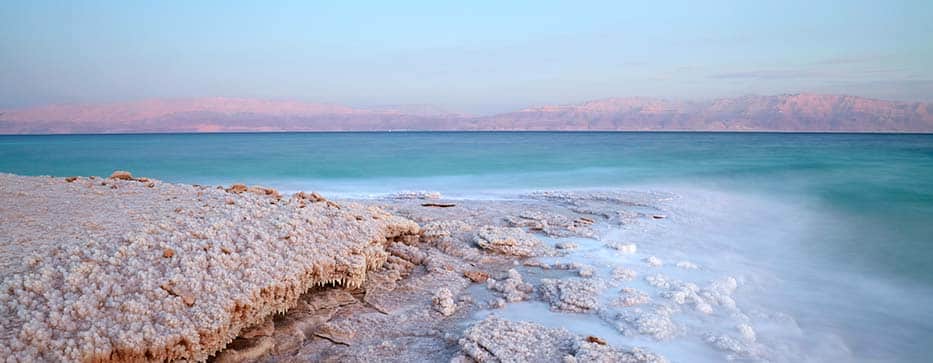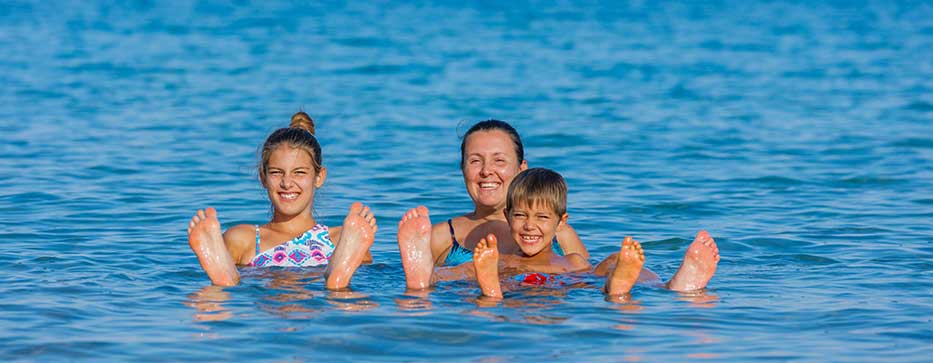The Dead Sea is one of the great tourist attractions of Jordan. And the Jordan Valley is a space of great symbolism for the country, because in fact it gives it its name. Therefore, our circuits usually dedicate some days to this area, because here are concentrated some of the most interesting places for the traveler. In this section you can learn more about what to see in the Dead Sea and the Jordan Valley, as well as other information on what to do if you are going to spend a few days here.
The Dead Sea and the Jordan Valley are two closely related places. In fact, the second ends in the first, which despite its name is not a sea but an endorheic lake. They form much of Jordan’s western border, marking the boundary with Israel and the Palestinian Territories (West Bank).
The Jordan Valley, in fact, also runs through the
north of the country
, but we group it in the same section with the Dead Sea because its main place of interest is very close: Bethany Beyond the Jordan, shortly before the Jordan River flows into this great body of water.
The Dead Sea, on the other hand, forms one of the most unique spaces in the world. And that’s for two reasons:
Indeed, the climate at the Dead Sea it is extreme, with temperatures hovering around (and often exceeding) 40ºC in the summer months. To this is added the effect of humidity, which can cause a suffocating sensation in that period. Therefore, from May to October is considered a period of less influx of visitors: if you decide to come at this time you must be well mentalized and prepared for it, especially to combat sunstroke (although here ultraviolet radiation is lower than at sea level due to the effect of atmospheric pressure) and humidity, (although also to a lesser degree than the humidity of a ‘normal’ sea, at 0 masl).
In the Jordanian part of the Dead Sea three sectors can be distinguished, since its size is considerable (about 100 km from its northern end to its southern end):
The Dead Sea it is a body of water that, due to its location and uniqueness, has occupied a prominent role in the history of the Middle East. Relevant events have occurred here in the formation of the three main monotheistic religions, both on the Israeli-Palestinian and Jordanian shores.
For example, it is believed that on the southern shores, near the Lizán Peninsula, were the cities of Sodom and Gomorrah, burned with fire and brimstone by God due to their grave sins, around the third millennium BC, although there is no conclusive evidence of this. After the destruction, Lot, Abraham’s nephew, would have taken refuge in what is now known as Lot’s Cave.
A few centuries before the birth of Christ, this area was already well known to the Nabataeans (people with capital in
Petra
), who used the natural asphalt that originated here to export it to Ancient Egypt, where its inhabitants used it in the process of embalming the mummies.
The ancient Greeks were also aware of this special body of water, which they called it Sea of Salt, Pestilent Sea and finally, they gave it the name of Dead Sea, because they appreciated that the high salinity made the existence of aquatic life practically impossible.
At the change of era, this area also played an important role, as John the Baptist or St. John the Baptist performed his baptisms not far from here, several kilometers north of the Dead Sea., especially that of Jesus Christ, in the very waters of the Jordan River. It is the place known as Bethany More of the Jordan. In addition, John the Baptist also died in the area, specifically in Machaerus, a fortress-palace currently in ruins, in the village of Mukawir.
In Byzantine times it was also home to Orthodox Christians, especially monks who lived in austere monasteries located on both shores of the Dead Sea.. Centuries later the place remained practically uninhabited and it was not until the nineteenth century when it was the subject of explorations, especially to check if its salt-rich waters could be exploited, something that already happened in the twentieth century: the evaporation basins located to the south are plants for obtaining potash and fertilizers, that Jordan exports.
Also in the twentieth century progress was made in archaeological discoveries and, above all, the Dead Sea. It was opened to tourism, with the construction of spas and resorts in its northern sector. On its future, there is debate, because climate change and the surrounding farms could be affecting the Jordan River and the Dead Sea, which have seen their flow and capacity seriously reduced in recent decades.

There is no doubt that the vast majority of tourists who come to the Dead Sea They do it attracted by their spas: as we tell you on
this other page
, there are numerous spas and resorts with private beaches where you can enjoy a day of thermal well-being. However, if you are going to spend several days here and want to escape at some point to see other things, you will find several interesting places. what to see in the Dead Sea and its surroundings.
Due to the great uniqueness of this space, Jordan has taken the opportunity to build two thematic museums:
Travelers more interested in religion and history will be attracted by the archaeological site of Machaeron or Machaerus, next to the small village of Mukawir, about 10 km from the shore of the Dead Sea., in the central sector. They are the ruins of the Castle of Herod the Great, a fortress of the first century BC where events of the first magnitude occurred, specifically the imprisonment and subsequent beheading of John the Baptist, at the instigation of Salome. The fortress was also a palace, on top of a hill from where you can see all the Dead Sea, and today only some wall canvases and some columns are preserved, but only the suggestion of remembering that episode will be very evocative for the visitor.
Further south of the Lizán Peninsula, next to the evaporation basins (used to extract phosphates from the water and export them as fertilizers), you will find Lot’s Cave. Specifically, in the hills of Ghor as-Safi: to get here you have to complete an important climb on foot, which begins near the Museum of the Lowest Point on Earth.
In this cave, at the end of the twentieth century, a cave was discovered and during archaeological work ceramics from the Bronze Age were recovered. But the important thing is that it is believed that Lot, Abraham’s nephew, dwelt here, finding refuge in his flight after the destruction of Sodom and Gomorrah. This speculation is based on the finding of an inscription that would mention Lot. In addition, there are remains of a small Byzantine church and mosaics dating from that same time (between the fifth and seventh centuries).
And another related attraction, although located further north, is the salt statue of Lot’s wife: according to the Bible, it was transformed into a column, pillar or statue of salt by looking back when escaping Sodom with his family, of which he had been expressly warned by two angels. Such a salt statue has been identified with a rock formation north of the Lizan Peninsula, at the height of Wadi Al Mujib.
In addition to all this, we remind you that another of the essential places to see in the Dead Sea and its surroundings is
Bethany Beyond the Jordan
, the place where Jesus Christ was baptized by St. John the Baptist. We give you all the information
on this page
. It is the most interesting place in the Jordan Valley, because upstream, further north, the river is quite deteriorated today.

In addition to the previous proposals to see in the Dead Sea, you can dedicate your time to other interesting activities. From an ecological point of view, you can go to the Wadi Al Mujib Biosphere Reserve. Here there are hiking trails that run through its most representative spaces, such as its different water cannons, in some of which it is possible to cool off. This protected area has a surprising variety of plants, such as orchids, and an interesting diversity of animals, with special mention of migratory birds and mammals such as the striped hyena or the Afghan fox.
The sport that can be practiced in the Dead Sea It is, like its climate and environment, extreme. The Jordan Trail passes through here, crossing Jordan from north to south: this section is 78 km, in four stages. But the test par excellence is the Dead Sea Ultra Marathon, which should not be confused with the ‘normal’ Marathon held on the Israeli side of the sea. It is usually held in May, with the final finish line in Amman Beach.
Much easier and refreshing is to take a dip in the Water Park of La Cueva Aqua Park, located on the outskirts of Swemeh, which represents one of the best leisure proposals for those who travel to the Dead Sea as a family.
And for those looking for a thermal bath and more relaxing, you can take a look at our page on spas and beaches in the Dead Sea.
The Jordanian shore of the Dead Sea is connected from north to south by the Jordan Valley Road, also known as the Dead Sea Highway., which originates in the capital, Amman, and extends south to Aqaba. From it leaves a branch to Wadi Musa (Petra). In addition, some roads save the great unevenness existing with the Highlands to connect this road with the
King’s Road
, authentic north-south axis of the country. These small roads follow the course of wadis and crossing them is an experience in itself, connecting the Dead Sea with also interesting cities such as Madaba or Karak.
To the north, the gateway is Sweimeh. It is actually a small town, which does not have a bus station. The JETT company does not include it in its network of large bus routes, and only gets here through specific tourist packages.
Therefore, faced with a practically non-existent public transport system, with only a few taxis and minibuses, the best option to get to the Dead Sea It is the private vehicle. This is an indicative list of distances and durations for trips up to the Dead Sea, taking Sweimeh as a reference for its large concentration of spas and resorts:
The Dead Sea It lacks large cities in its immediate surroundings, so the service network is limited. That includes gas stations, which are really scarce here, so if you’re going to get around in a rental car, we recommend filling up the tank before you arrive, just in case.
In addition, we must not forget that this is a border area, in some cases ‘hard’, which may imply a visible presence of police and security forces, who can carry out routine or extraordinary controls. Therefore, it is recommended to always carry your passport and documentation with you.
To obtain information about the Dead Sea in situ
, you can request it at your hotel or from our staff, in the case of making the circuit with us, since there are no tourist offices or interpretation centers of the environment, beyond the two museums mentioned above.






Fill out the form below to receive a free non-binding quote tailor-made by a specialized agency in Jordan.
DMC travel agency specializing in tailor-made trips to Jordan
Mandala Tours, S.L, NIF: B51037471
License: C.I.AN-187782-3